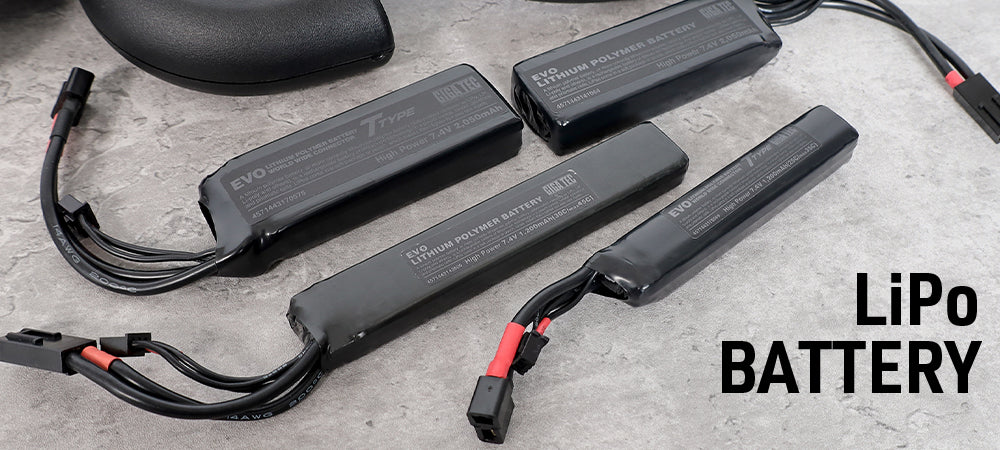
How to use LiPo batteries safely? A Complete Guide to Electric Guns, Charging, and Storage
LiPo batteries are now being used in electric guns made overseas.
We often hear stories about air guns
“Semi-auto response is better with LiPo batteries!
“The response is better now!
or “The response is better!
In Japan, the use of LiPo batteries in the Tokyo Marui P-90 Plus electric gun has become widely recognized.
On the other hand, those who have been studying about LiPo batteries may be wondering
“LiPo batteries are dangerous because they can ignite.
“They are difficult to handle.
and “they seem to be difficult to handle.
However, it is not difficult.
When you receive your LiPo battery, first read through the instructions, cautions, and warnings that come with it.
For safe and long-lasting use, you must use it in the correct manner!
Ultimately, that's all there is to it.
It does not mean that you need to do anything special that is not mentioned in the manual.
Here, we hope you will gain a better understanding of LiPo batteries and how to use them safely and correctly.
What is a LiPo battery?
LiPo battery stands for “lithium-ion polymer battery” and is a type of lithium-ion battery.
They are used in cell phones, notebook computers, cameras, etc. because they are small and lightweight, yet can maintain a high voltage.
They do not have the “memory effect” of nickel-cadmium and nickel-metal hydride batteries, which are mainly used in Tokyo Marui electric guns, etc. Therefore, they do not require frequent conditioning, such as charging and discharging, and can be recharged in addition.
How to read the numbers on a LiPo battery
The following is an introduction to what each number on a LiPo battery represents.
Voltage [V].
A unit that expresses the force (momentum of electricity) to push out electricity.
Discharge capacity [mAh]
A unit that indicates the capacity of a battery.
Discharge capacity coefficient [C]
A coefficient used to calculate the current [A] of the battery.
Current [A].
A unit that expresses the amount of electricity flowing through the battery. It can be calculated by the following formula.
Discharge capacity [mAh] x discharge capacity coefficient [C] / 1000 = current [A]
Connector Differences
There are two connectors protruding from a LiPo battery for a typical electric gun.
One is a “balance (charge) connector” for charging and discharging, and the other is an “output connector” for connecting to an electric gun.
There are two types of “output connectors” in use.
One is the “Tamiya Mini Connector” used for Tokyo Marui electric guns, and the other is the “T-type Connector” used for KRYTAC, BCM, and other foreign-made electric guns.
Shape and current rating
Tamiya Connectors (Large Connectors): Rated Current 15A
Tamiya Mini Connectors: Rated current 10A
T type connectors: Rated current 50A
Mini T Connectors: Rated current 30A
Rated current is the amount of allowable current that a connector can carry. For example, a 1,200mAh, 30C LiPo battery can theoretically carry a maximum current of 36A.
However, if the allowable current rating is low, this becomes a bottleneck, and the connector may heat up during use, or in the worst case, the connector itself may melt.
This can also be a cause of heat generation when playing with a semi-automatic weapon in rapid succession instead of a full-automatic one.
Electric guns with powerful motors and electronic control boards require more electricity, so it is necessary to select an appropriate output connector.
Compared to Tamiya connectors, T-type connectors not only have a higher current rating, but are also smaller in size and can be stored in a smaller space.
LayLax offers not only LiPo batteries with T-connectors pre-installed, but also T-connectors by themselves.
How to check remaining battery level and status
As the remaining charge of a LiPo battery decreases, the voltage drops, affecting its operation.
The remaining charge and condition of LiPo batteries can be checked and adjusted by using the “Checker & Balancer”.
Check the voltage (value per cell)
The remaining charge and condition of LiPo batteries can be checked by connecting the balance (charge) connector to the “Checker & Balancer”.
4.3V or more: Overcharged. Move the batteries to a place where there is no danger of ignition and observe the situation.
Do not leave the battery in this state for more than one day.
3.9 to 3.7V: Suitable for long-term storage.
3.9 to 3.7V: Suitable for long-term storage.
● Below 3.0V: Over-discharged. Stop using it immediately and dispose of it. Recharging is not possible.
If there is a voltage difference of 0.1V or more between each cell of a LiPo battery, please use the balance mode of the “Checker & Balancer” to balance the cells.
Confirm by appearance and touch
Lipo batteries may swell during use due to deterioration and other factors. Please dispose of the batteries when they are swollen to the point of rupture or ignition.
If the outer skin is peeled off or damaged, do not charge or use the product.
Do not use the product if it is overheated.
The battery will become hot immediately after use in an electric gun. If the heat is not caused by a problem, allow the battery to cool to room temperature before recharging.
For detailed settings and values, please refer to the instruction manual for the LiPo battery you are using.
How to charge
First of all, most accidents involving the ignition of LiPo batteries are caused by “charging in the wrong way.
When charging LiPo batteries, be sure to use a charger designed specifically for LiPo batteries and confirm that the correct settings are used before starting charging. If you mistakenly charge with a charger or settings for nickel-cadmium batteries or nickel-metal hydride batteries, it may cause a serious accident such as ignition.
Even when using an advanced class charger with fine settings, incorrect settings can lead to ignition accidents.
We recommend using a charger made by the same manufacturer as much as possible, and the “Multi-Charger Evo BTC-01” should be used to charge the GIGA TEC LiPo battery series handled by LayLax.
When charging LiPo batteries, be sure to charge them with the batteries in the “safety bag.
To prevent accidents, do not leave the charger or battery unattended while charging.
The charger generates heat during charging, so please keep it out of the safety bag while charging.
Storage Instructions
●Be sure to disconnect from the electric gun when not in use. Leaving it connected to the electric gun while unattended may cause over-discharge or swelling.
Do not leave or store a fully charged battery for more than 1 day. When fully charged, use the “Checker & Balancer” to adjust the voltage until it reaches the storage voltage before storing it, and check the voltage 3-6 times a year.
● Always store LiPo batteries in a “safety bag” in a cool and safe place with good ventilation. Be sure to keep them in the “safety bag” even when carrying them when going savage.
*Do not place the batteries in a place where the temperature exceeds 30℃ (inside a car, near a fire or heater, in direct sunlight, etc.), near flammable materials, or in a humid place.
How to dispose of or dispose of LiPo batteries
Check local regulations: First, check your local waste disposal regulations and guidelines.
For safety reasons, the batteries must be completely discharged. Place the LiPo batteries one by one in the salt water so that they are completely submerged and leave them in the salt water for at least 3 days. If the voltage is zero on the “Checker & Balancer,” you are done.
Finally
You can avoid the risk of accidents with LiPo batteries by being very careful about how to use and charge them properly. Please read the instruction manual of your LiPo battery and charger carefully.
LayLax offers not only LiPo batteries, but also many other items that are necessary when handling LiPo batteries.
We also have custom parts to convert your electric gun to LiPo, so please check us out.
